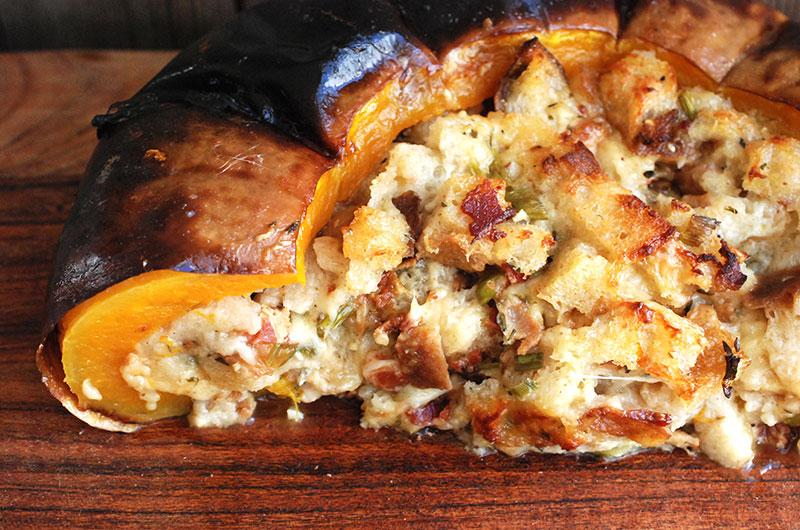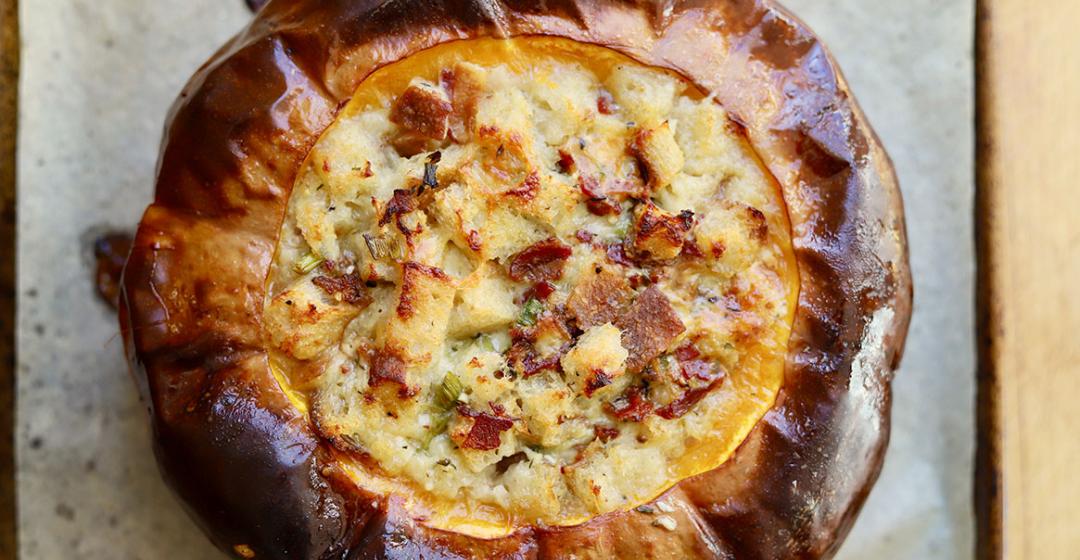Editor’s Note: This beloved recipe by cookbook author Dorie Greenspan was first published in her book, Around My French Table, in 2010 and has been widely shared since then. We wrote to her for permission to use it here on Cook the Vineyard this fall, and Dorie was happy for us to post it. She volunteered that, since receiving the outline of this recipe from a friend in Lyons, France, many years ago (Dorie lives in both Paris and Connecticut), she has varied it to use in different sizes of squash and pumpkins, most recently in a potimarron, a squash that is called kuri in the U.S.
I first followed Dorie’s recipe several years ago using a Long Island cheese squash (it resembles a Cinderella pumpkin) that Simon Athearn at Morning Glory Farm had given me. It just seemed like the perfect shape and size for stuffing, plus it had a reputation for delicious flesh. So in testing the recipe to post for Cook the Vineyard, I made it again in a Long Island cheese squash, though the smallest one I could find was about six pounds. Hence, I doubled the amount of stuffing in the recipe below to yield enough for that squash. (You can read more of my notes in the comments section below.) As Dorie points out, this is the kind of recipe that is more of an outline, though you will find pointers from her in the directions. The creamy, bready gruyere filling is rich, but along with the squash, makes a very hearty addition to a thanksgiving lineup (easily made into a vegetarian main dish by replacing the bacon with sautéed shiitakes). — Susie Middleton

Serves 4
- 1 sugar pumpkin or Long Island cheese squash, about 3 pounds (or more, see editor's note and increase stuffing proportionally)
- Salt and freshly ground pepper
- 1/4 pound stale bread, sliced and cut into 1/2-inch chunks
- 1/4 pound cheese, such as Gruyère, Emmenthal, cheddar, or a combination, cut into 1/2-inch chunks
- 2 to 4 garlic cloves (to taste), split, germ removed, and coarsely chopped
- 4 slices bacon, cooked until crisp, drained, and chopped
- About 1/4 cup snipped fresh chives or sliced scallions
- 1 tablespoon minced fresh thyme
- About 1/3 cup heavy cream
- Pinch of freshly grated nutmeg
Center a rack in the oven and preheat the oven to 350° F. Line a baking sheet with a silicone baking mat or parchment paper, or find a Dutch oven with a diameter that’s just a tiny bit larger than your pumpkin. If you bake the pumpkin in a casserole, it will keep its shape, but it might stick to the casserole, so you’ll have to serve it from the pot – which is an appealingly homey way to serve it. If you bake it on a baking sheet, you can present it freestanding, but maneuvering a heavy stuffed pumpkin with a softened shell isn’t so easy. However, since I love the way the unencumbered pumpkin looks in the center of the table, I’ve always taken my chances with the baked-on-a-sheet method, and so far, I’ve been lucky.
Using a very sturdy knife – and caution – cut a cap out of the top of the pumpkin (think Halloween Jack-o-Lantern). It’s easiest to work your knife around the top of the pumpkin at a 45-degree angle. You want to cut off enough of the top to make it easy for you to work inside the pumpkin. Clear away the seeds and strings from the cap and from inside the pumpkin. Season the inside of the pumpkin generously with salt and pepper, and put it on the baking sheet or in the pot.
Toss the bread, cheese, garlic, bacon, and herbs together in a bowl. Season with pepper – you probably have enough salt from the bacon and cheese, but taste to be sure – and pack the mix into the pumpkin. The pumpkin should be well filled – you might have a little too much filling, or you might need to add to it. Stir the cream with the nutmeg and some salt and pepper and pour it into the pumpkin. Again, you might have too much or too little – you don’t want the ingredients to swim in cream, but you do want them nicely moistened. (It’s hard to go wrong here.)
Put the cap in place and bake the pumpkin for about 2 hours – check after 90 minutes – or until everything inside the pumpkin is bubbling and the flesh of the pumpkin is tender enough to be pierced easily with the tip of a knife. Because the pumpkin will have exuded liquid, I like to remove the cap during the last 20 minutes or so, so that the liquid can bake away and the top of the stuffing can brown a little.
When the pumpkin is ready, carefully, very carefully – it’s heavy, hot, and wobbly – bring it to the table or transfer it to a platter that you’ll bring to the table.
To serve, you have a choice – you can either spoon out portions of the filling, making sure to get a generous amount of pumpkin into the spoonful, or you can dig into the pumpkin with a big spoon, pull the pumpkin meat into the filling, and then mix everything up. I’m a fan of the pull-and-mix option. (Editor’s note: Depending on the type of pumpkin or squash, you may also be able to cut the stuffed cooked pumpkin into wedges after it cools just a bit.)





 3 comments
3 comments


Comments (3)